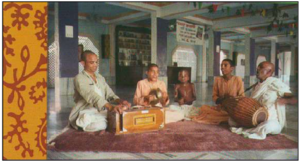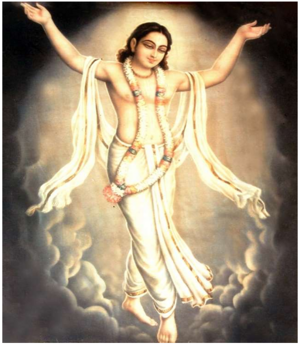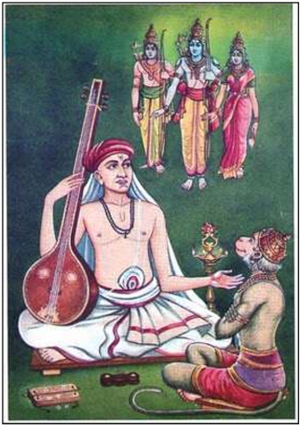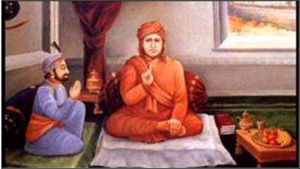Talk:Kīrttanaṃ (Sacred Music)
By Vishal Agarwal
Every day, we speak thousands of words, most of which are useless and without much meaning. We whine, complain, gossip, yell, and engage in empty chatter. A higher use of the tongue is to sing the glories of Bhagavān with love and faith.
Kīrttanaṃ means singing and chanting the glories of Bhagavān through bhajana-s (devotional songs), stotra-s (Sanskrit hymns), mantra-s (Vaidika verses), or narrating the kīrti (fame) of the Lord with melody. It shares overlap with Vandanaṃ (praise), but Kīrttanaṃ explicitly includes the use of music.
The tradition exalts devotional music. The Sāmaveda — one of the four Veda-s — is the world’s oldest liturgical musical tradition.[1] Today, over 8000 musical modes exist for its chanting.
Scientists have shown that devotional music positively affects the nervous system and concentration, similar to Yoga.
One who is accomplished in playing the Vīṇā and expert in the 21 śruti-s, jāti and tāla attains the path of mokṣa effortlessly. Yājñavalkya Smṛti 3.115
The music expert who fails to attain mokṣa through yoga nevertheless becomes a companion of Rudra and rejoices with him. Yājñavalkya Smṛti 3.116
O People! Worship Indra with melodious songs; sing, O Priyamedhas, with reverent devotion. Let even children join in praising Indra, mighty as a fortress. Ṛgveda 8.69.8
With righteousness, meditation, and laudatory songs, the devotees loudly extol the valiant and efficient Soma.' Ṛgveda 9.63.21
Devarṣi Nārada is the prime example of a Kīrttana practitioner. Wandering across realms, he constantly sings the names of Nārāyaṇa and plays the Vīṇā. His treatise on music is still studied by scholars.
Saint Caitanya (1486–1534 CE) revitalized this practice through public processions of devotional singing called Nāgara-kīrttana.
His followers developed many of the bhakti traditions across India and gave rise to a renaissance in devotional music. Non-Hindus across the world have adopted kīrttana in their spiritual lives.[2]
Japa is silent or private chanting, while Kīrttana is public and musical.[3]
Kīrttana is especially potent in this age of decline (Kali Yuga).
Kali Yuga, though full of evil, has one blessing. Merely through kīrttana, one may attain liberation and reach Kṛṣṇa. What is gained in Satya Yuga through meditation, in Tretā through yajña, and in Dvāpara through worship, is attained in Kali Yuga through singing Hari’s name. Bhāgavata Purāṇa 12.3.51–52
Story: Kīrttana Is the Bhakta’s True Treasure
Saint Tyāgarāja (1747–1847 CE), refused royal patronage because he preferred singing Rāma’s name over worldly riches. His song declared that sannidhi (divine presence) is worth more than nidhi (royal treasure). After losing his mūrti-s, he later rediscovered them through a divine vision, confirming Rāma’s grace.
Story: Kīrttana Without Selfish Motive A man once asked Caitanya Mahāprabhu what he gains from kīrttana. The saint replied, “This question never occurred to me. I chant because it is my nature.”
Story: Reform of Amicandra Through Devotional Singing
Swāmī Dayānanda Sarasvatī had a disciple named Amicandra, an alcoholic who was skilled in music. Swāmī encouraged him to sing bhajana-s, and over time, this devotion reformed his character and purified his life.
Story: Miracle at Vedaranyam Mandir Saints Appar and Jñānasambandhar sang to Śiva outside the locked gates of the Vedaranyam temple. As they completed their hymns, the locked temple doors miraculously opened, showing the transformative power of kīrttana.




